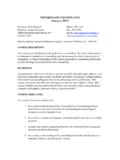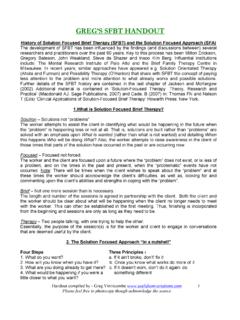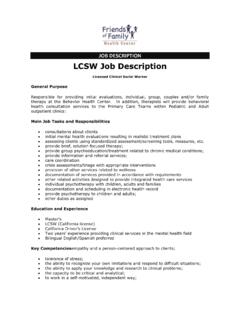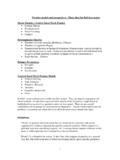Transcription of Tapping with Children - Evidence Based EFT
1 Tapping with Children A General Overview of Tapping Emotional Freedom Techniques (EFT) is often called Tapping ' or psychological acupuncture'. It is brief technique combining elements of exposure and cognitive therapy , and somatic stimulation and uses a two finger Tapping process with a cognitive statement. EFT has been researched in more than ten countries, by more than sixty investigators, whose results have been published in more than twenty different peer-reviewed journals (over 100 publications). The EFT Mini Manual is available free here: The Standard EFT Process Usually there is something you want to change and you rate your level of distress or discomfort around this out of ten (10 = most distress, 0 = no distress). You then state a negative thought or feeling you have (associated with a specific emotional event), and pair this with a self-acceptance statement. Even though I am scared of heights, I accept this about myself.
2 As you say this setup statement, you tap on the side of one hand (see fig. 1 below). saying the setup statement three times. You then tap through all eight Clinical EFT points (see fig. 2) while saying a short reminder phrase, which is usually the main feeling or body sensation, or thought ( this fear). You then take a breath and re-rate your distress out of 10. Tap again from the eyebrow point through all points, until your rating is 0. (You only need to start again with the setup statement if you want to change the topic you are Tapping on.). 1. Figure 1. Side of hand The 8 Tapping Points Figure 2. Tapping Points 2. How Can Tapping be Used for Children ? Tapping can be taught to Children for things such as: stress pain fear/worry bullying resilience self esteem and more . It is important to note that when using Tapping for Children use their EXACT words;. tap with the child;. use bears/puppets as aides if useful.
3 Children don't usually have so many layers to their issues;. don't often need the movie technique (see eft- Tapping -tips-the-movie-technique for more detail on this) to work through a past event;. usually just need to tap on the exact feeling and it collapses quickly;. often feel sensations in their body and you can focus there. Teens and older Children need you to assume nothing;. need you to tap with their exact words too don't infer anything;. may need the movie technique if they have a past memory still bothering them. 3. Here is an Outline to Use When Tapping with Younger Children Tips Before You Start: 1. Younger Children (less than ten years), often only need to use four points instead of the standard eight. These are outlined below. 2. Use both hands to tap to keep Children engaged. 3. Children often respond to Tapping with a puppet or bear that has the points on them. (See for bears that can be used.)
4 4. As well as using the child's exact words for the problem part of the setup statement, you also need to use an ending that feels relevant to the child. Here are some variations that Children can use for the setup statement: Even though I have this problem (insert actual words).. I still like myself. Even though I have this problem (insert actual words).. I can forgive myself for this. Even though I have this problem (insert actual words).. I want to change this today. Even though I have this problem (insert actual words).. I want to let this go. Even though I have this problem (insert actual words).. I will be OK. Even though I have this problem (insert actual words).. I am OK. Even though I have this problem (insert actual words).. my mum/dad/pet/teacher still likes (or loves) me. 4. The Process: Begin by saying: The first step is to THINK ABOUT YOUR PROBLEM. (If the child is already upset you can skip this part, as it is obvious the child is thinking about the issue or feeling.)
5 Then say something like: This exercise will calm you down and help you think more clearly about your problem. If you learn this exercise you can be upset only when YOU. chose to be upset.. Next say: Now we want to know how upset you are. (For younger Children use out-stretched arms to measure how upset the child is. Use hands in a prayer position indicating no upset. Older Children may have no problem with telling you on a 0 to 10. scale how upset they are.). Now say: OK, the first step is to tap the side of your hand. Using your hand as an example, show them how to tap on the fatty side of the hand. You can tell the child it is called the side of the hand spot. This spot can also be introduced as the friendly spot as that is where you touch another person's hand when you shake hands to show you are friendly'. Make a set-up statement such as: Even though I have this problem, I am a super kid.. First Tapping ' point: use three or four fingers and tap between the eyebrows.
6 (Tap about seven times.). Second point: use two fingers of both hands and tap on the bony part under both eyes. (Tap about seven times.). Third point: use a closed fist to the chest just below and to the left of the throat for the collarbone spot. (About seven times.). 5. Fourth point: tap under both arms. This is like giving a yourself a hug. Wrap arms around your body and pat under both arms about a palm width below the armpit. For younger Children you can call this the monkey spot' and have them tap with each hand under the same arm. They get a kick out of this! (Tap about seven times.). Repeat this exercise three times for a particular problem or until the upset goes away. Sometimes when one problem is calmed another related problem comes up and the child must repeat the process for the second problem. Tapping with Older Children (above ten years). When Tapping for older Children you can use the same process as with adults which includes the full eight points outlined earlier.
7 Extra Ideas: 1. Using I CHOOSE Statements Dr Patricia Carrington pioneered the I Choose statements to help the beneficial changes from EFT become permanent and generalize to many aspects of your life. To do this, you add the words I choose to the end of the setup statement. Examples: Even though I feel my sister is mean to me, I choose to love myself anyway. Even though I feel angry at my teacher, I choose to be calm when I am doing my school work. Even though I'm nervous about giving that talk on Tuesday, I choose to be calm and confident 2. Positive Tapping Most people only tap when they feel a negative feeling. But you can use Tapping for positive statements. It is highly recommended you only do this AFTER you have reduced any negative feelings associated with a memory, thought, or feeling. You can then do some rounds of positive Tapping to instill any new feeling or belief you would like to have. Examples: Even though I was really nervous about giving that talk next week, I now feel calm and confident.
8 (You can use calm and confident' as the reminder phrase.). Even though I have had that headache for days, I now feel clear and focused. (Reminder phrase is clear and focused .). 6. Tapping in the Classroom This is a brand new training program the first in the world and is Based on clinical research trials conducted in schools. This program teaches EFT for use in a classroom and is designed as a training for teachers. You can attend in person or do it online. The in-person training is two days and covers the basics of EFT and how to apply to common academic, social and peer concerns. Our research trials have found the following issues are common in classrooms: anger, anxiety, bullying, perfectionism, judgment, morale and motivation. The online version is an 8-module program and is self paced. Both program styles have online support which is ongoing. Websites for Children ( Tapping in the Classroom is a teacher training for classroom use of Tapping on a daily basis).
9 Children -and-teens 7. Tapping Books for Children Huggi the Bear by Laura Louise Love This book is perfect for Children aged two to six years. Huggi the bear shows kids simple, easy to use Emotional Freedom Techniques (EFT) and positive affirmations using the four points for younger Children . Laura Louise Love ( Psych Dip. Psych) is the Australian artist and author of this self-help resource. She works as a school psychologist for the Tasmanian Department of Education. Laura started out her career conducting practical therapy with Children with clinical behavioural problems and also on the autism spectrum. Gorilla Thumps and Bear Hugs by Alex Ortner This book is ideal for Children aged four to eight years. Annabel dreams of one day being a scientist, but teasing from other kids at school has hurt her confidence and left her feeling sad and alone. Join her as she learns how to use the magical Tapping technique to quickly release her sadness and regain her confidence.
10 Through the book, you'll learn about the scientifically proven technique commonly known as Tapping and how you can use it for both yourself and your child to overcome stress, anxiety, negative emotions, and much more. Your child will love the fun descriptions and illustrations for each point, such as the Super Eagle Eye Point, Lion Cry Point, Dragon Fire Point and Wolf Point. Your child will be having a blast as they howl, hug, thump on their chest and act like a all while learning how they can use Tapping to help themselves in real life! Author, Alex Ortner, is the proud father of three amazing Children : Malakai, Lucas, and Olivia. He and his wife, Karen, live with their Children in Newtown, CT. Alex works with his brother, Nick, the New York Times best-selling author of The Tapping Solution, and his sister, Jessica, the New York Times best-selling author of The Tapping Solution for Weight Loss and Body Confidence.






